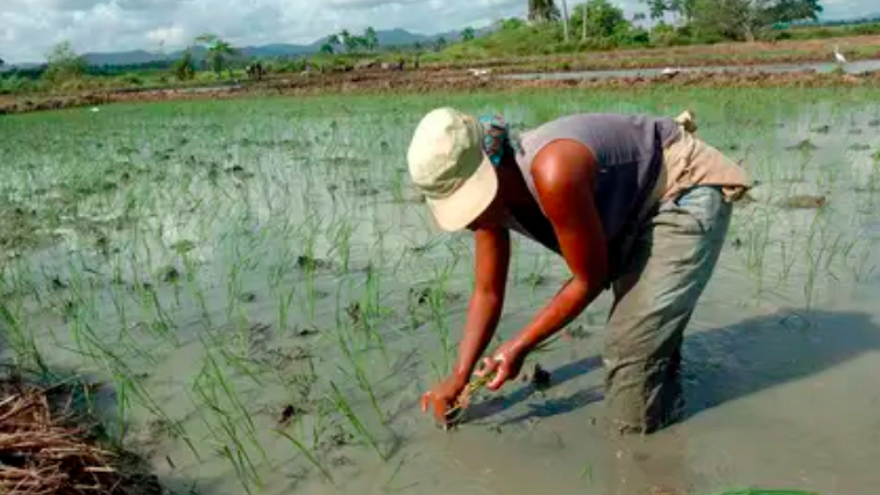
![]() 14ymedio, Havana, 20 September 2022 — The discomfort of Cubans due to the lack of basic necessities and food in the face of the unbridled pace of construction and renovation of hotels is not just a mere perception. Official figures show that divestment in agriculture is a reality that coexists with wasted investment for tourism.
14ymedio, Havana, 20 September 2022 — The discomfort of Cubans due to the lack of basic necessities and food in the face of the unbridled pace of construction and renovation of hotels is not just a mere perception. Official figures show that divestment in agriculture is a reality that coexists with wasted investment for tourism.
According to data published by the National Office of Statistics and Information (ONEI) last Friday, of the 31,673 million pesos invested by the Government between January and June of this year, 10,692 were dedicated to “business services, real estate and rental activities,” the heading that covers most of the investment in hotels and tourism. This accounts for a third of all state investment.
At the same time, the numbers reveal that only 830 million pesos were dedicated to agriculture, livestock and forestry, and 225 million were dedicated to fishing.
But these figures are even more astonishing in perspective, as can be seen in the graphs prepared by the Cuban economist Pedro Monreal from the history of production in the last nine years. Between 2013 and 2021, the tons of rice generated by the country fell by -66.4% while hotel rooms grew by 125%. Food also shows a strong reduction compared to tourism, although its decrease is smaller, with -5.7%.
However, rice is not the only crop in collapse: beans, another basic product of accompaniment in Cuban cuisine, also fell by -55.5% this year, compared to 2013. Vegetables also lost, with -28.8%.
“Cuba’s distorted investment priorities are reflected in disparate results: the 10.7% increase in hotel rooms in 2022 compared to 2017, when 4.6 million visitors were welcomed with far fewer rooms, coexists with a deep agricultural crisis,” Monreal points out, comparing the last five-year period.
That year was the golden moment of the tourism sector, and the Island received 4,689,898 visitors. Since then, with the tightening of the embargo, the pandemic and the poor market recovery, the data have been falling. For this year, the authorities maintain their target of 2.5 million tourists, but during the first half of the year, 682,297 travelers arrived, almost 500% more than in 2021, which is no relief, since in 2019 by this time, 2.6 million people had arrived in Cuba for vacation.
Monreal also notes that the weight of investment in “business services, real estate and rental activities” was even greater in 2020, when it took 45.6% of the total allocated. “But it’s still irrational in the context of food insecurity, with agriculture receiving only 2.6%,” he emphasizes.
Now the imbalance is even greater, since in 2020 almost 6% was invested in agriculture, with 7.7 times more investment in real estate. At present, the percentage is 13 times higher than for farming. “The overcoming of the food insecurity crisis in Cuba requires that, at a minimum, 8% of total national investment be devoted to agriculture — especially the private sector — which would be equivalent to approximately 5,000 to 6,000 million pesos per year,” says the economist.
Despite having the precise data of negligible investment dedicated to the countryside, the Government ventures to ask in public what is happening so that Cubans don’t manage to produce. This Monday, Cuban President Miguel Díaz-Canel visited Camajuaní, in Villa Clara, and went to the estate of Yusdany Rojas Pérez, belonging to the Juan Verdecia cooperative. The young man is successfully dedicated, according to the account of the presidency and the official press, “to pig breeding, the planting of crops as the main source of animal food, shade-grown tobacco and the planting of cane.”
“If he can do it, why can’t others?” the president asked. A question shamelessly copied by the official newspaper Granma to present Rojas Pérez as an example to the detriment of thousands of farmers who aren’t mentioned in daily reports.
“When I ask him about the keys to his success in the company where he works,” says the State newspaper, “he doesn’t hesitate for a moment to say: ’I’m not someone who starts crying in the face of problems; I always see the positive side of things and try to look for options to get afloat.’”
Granma, which ends up giving some advice to the farmers to increase production, considers this a success story, and “evidence (…) that despite the difficulties the country is going through, if someone works with passion and without fear of facing obstacles and problems, results can happen.” The fact that the Government invests less than a billion for the population to eat doesn’t seem to be newsworthy to the official press.
Translated by Regina Anavy
____________
COLLABORATE WITH OUR WORK: The 14ymedio team is committed to practicing serious journalism that reflects Cuba’s reality in all its depth. Thank you for joining us on this long journey. We invite you to continue supporting us by becoming a member of 14ymedio now. Together we can continue transforming journalism in Cuba.
